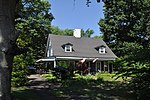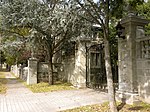East Rock Park
Historic districts in New Haven County, ConnecticutHistoric districts on the National Register of Historic Places in ConnecticutNRHP infobox with nocatNational Register of Historic Places in New Haven, ConnecticutParks in Hamden, Connecticut ... and 5 more
Parks in New Haven, ConnecticutParks on the National Register of Historic Places in ConnecticutQueen Anne architecture in ConnecticutShingle Style architecture in ConnecticutUse mdy dates from August 2023
East Rock Park is a park in the city of New Haven and the town of Hamden, Connecticut that is operated as a New Haven city park. The park surrounds and includes the mountainous ridge named East Rock and was developed with naturalistic landscaping. The entire 427-acre (173 ha) park is listed on the National Register of Historic Places.
Excerpt from the Wikipedia article East Rock Park (License: CC BY-SA 3.0, Authors).East Rock Park
New Haven
Geographical coordinates (GPS) Address Nearby Places Show on map
Geographical coordinates (GPS)
| Latitude | Longitude |
|---|---|
| N 41.328055555556 ° | E -72.905833333333 ° |
Address
06517 New Haven
Connecticut, United States
Open on Google Maps








